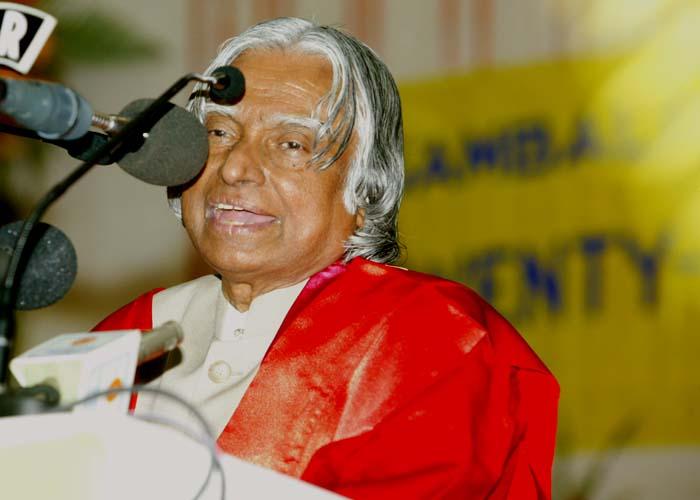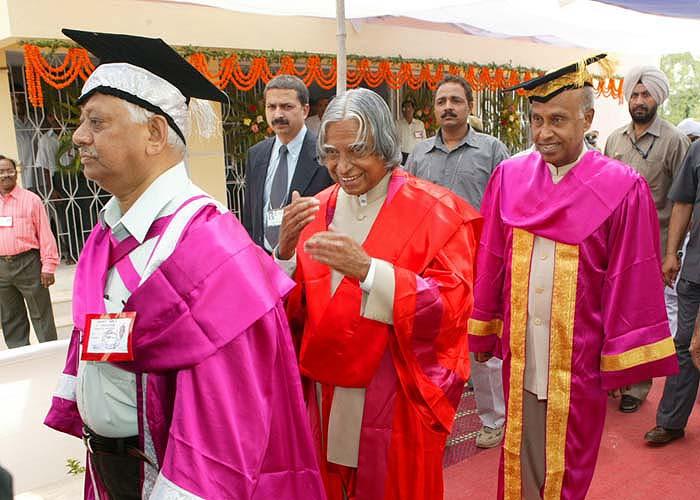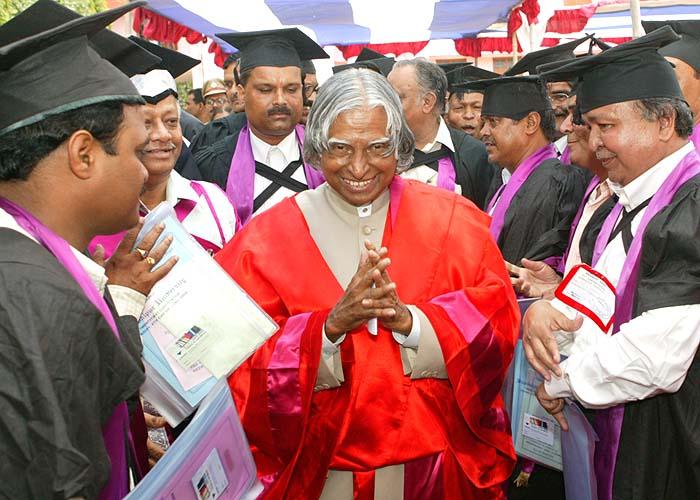Address at the 21st Convocation of Sambalpur University, Sambalpur
Sambalpur : 04-06-2004
INDOMITABLE SPIRIT
I am indeed delighted to participate in the twenty-first Convocation of the Sambalpur University. When I am in Sambalpur I realize I am in the land of renowned freedom fighter Surendra Sai of Western Orissa. Of course based on the selfless services of many leaders from 1857 to 1947 we got our independence and now we are on a mission of transforming India into a prosperous, happy and safe nation.
I congratulate the graduating students for their academic excellence. My greetings to the Chancellor, Vice Chancellor, professors, teachers and staff members of the University for shaping the students for high performance in various fields of studies and above all as enlightened citizens of the country.
Sambalpur University was established with the mission of providing higher education to the tribal and socially and economically backward students from western Orissa. I am happy to know that in the last two decades, the enrolment of students from weaker section of the society has increased to 25% of the total student strength. Since I am in the academic ambience with teachers and students I would like to share my experience with a unique teacher whom I met in my early phase of life which really changed my mission in life.
The design teacher : Prof Satish Dhawan
I worked in Delhi with the Ministry of Defence. Later I joined Defence Research and Development Organisation (DRDO) in 1958 at Aeronautical Development Establishment at Bangalore. There, I took up the development of Hovercraft. Hovercraft design needed the development of a ducted contra- rotating propeller for creating a smooth flow balancing the torques. I did not know how to design a contra-rotating propeller though I knew how to design a conventional propeller. Some of my friends told me that I can approach Prof. Satish Dhawan of Indian Institute of Science, who was well known for his aeronautical research, for help in designing the ducted contra-rotating propeller.
I took permission from my Director Dr. Mediratta and went to Prof. Satish Dhawan who was sitting in a small room in Indian Institute of Science with lot of books in the background and a blackboard on the wall. Prof. Satish Dhawan asked me what was the problem that I would like to discuss? I explained the problem to Prof. Dhawan about my project work. He told me that it is really a challenging task and he would teach me the design if I attend his classes in IISc between 2.00 p.m. to 3.00 p.m. on all Saturdays for the next Six weeks. He was a visionary teacher. He prepared the schedule for the entire course and wrote it on the black board. He also gave me the reference material and books I should read before I start attending the course. I considered, this as a great opportunity and I started attending the discussion and started meeting him regularly. Before commencing each meeting, he would ask critical questions and assess my understanding of the subject. That was for the first time that I realized how a good teacher prepares himself for teaching with meticulous planning and prepares the student for acquisition of knowledge. This process continued for the next six weeks. I got the capability for designing the contra-rotating propeller. Prof. Dhawan told me that I am ready for developing the contra-rotating propeller for a given hovercraft configuration. That was the time I realized that Prof. Satish Dhawan was not only a teacher but also a fantastic development engineer of aeronautical systems.
Later during the critical phases of testing Professor Dhawan was with me to witness the test and found solutions to the problems. After reaching the smooth test phase, contra-rotating propeller went through 50 hours of continuous testing. Prof. Satish Dhawan witnessed the test himself and congratulated me. That was a great day for me when I saw the contra rotating propeller designed by my team performing to the mission requirement in the hovercraft. However, at that time, I did not realize that Prof. Satish Dhawan would become the Chairman of Indian Space Research Organisation (ISRO) and that I would get the opportunity to work with him as a Project Director in the development of first satellite launch vehicle SLV-3 for injecting the Rohini Satellite into the orbit. Nature has its own way to link the student?s dream and the real life later.
Design of contra rotating propellar was the first project in my career which gave me the confidence to design many complex aerospace systems in future. The hovercraft could fly just above the ground level carrying two passengers. I was the first pilot for this hovercraft and I could control and maneuver the vehicle in any direction. Through this project I learnt the techniques of designing and developing the contra-rotating propeller. Above all, I learnt that in a project, problems will always crop up; we should not allow problems to be our masters but we should defeat the problems. The lessons that I learnt from Prof Satish Dhawan for the next four decades are: the importance of design capability and the need for indomitable spirit. Let me pray for you, all the young, to gain the experience what I experienced.
Employment Generation through entrepreneurship
When I see you all in this campus during this Convocation, I realize the importance of employment generation. There has been substantial growth in our educational system and we are generating over 3 million graduates every year and another 7 million educated upto 10 or 10+2 level. However, our employment generation system is not in a position to absorb the graduates passing out from the universities leading to increase in educated unemployed, year after year. This situation will lead to instability in the social structure. We need education integrated with an entrepreneurial spirit. A multi pronged strategy is needed to make education more attractive and simultaneously create employment potential ? how do we do that?
Firstly, the educational system should highlight the importance of entrepreneurship and prepare the students right from the school and college education to get oriented towards setting up of the enterprises which will provide them creativity, freedom and ability to generate wealth. Apart from entrepreneurship, the youth should have the spirit that ?we can do it?. Secondly, the banking system should provide venture capital right from every village level to the prospective entrepreneurs for undertaking new enterprises. Banks have to be proactive to support the innovative products for enabling wealth generation by young entrepreneurs by setting aside the ?conventional tangible asset syndrome?. Definitely this involves certain amount of calculated risks which can be eliminated by making an analysis of successful venture capital enterprises. Thirdly, there is a need to identify marketable products and enhancement of purchasing power among the people. This can come through the implementation of mega programmes such as rural prosperity through connectivity (RUPCON), Interlinking of Rivers, Infrastructure missions, Power missions and Tourism.
The universities should become a facilitator for creating this entrepreneurship scheme through the support of the banking system and the marketing system. This is one way of reducing the employment gap leading to upliftment of the 260 million people living below the poverty line.
An island transforming into a missile launch complex
I was working in India?s missile programme during 1982 to 1999. Even though my place of work was Hyderabad, my theatre of action was always Chandipur and Wheeler Islands of Orissa coast where the developed missiles were flight tested. I would like to narrate an interesting experience which happened during that period.
In October 1993, the development of Prithvi missile was almost over. However, the Army desired to have a confirmatory test, on a land range, to validate the Circular Error Probability (CEP) of the missile. Our efforts to conduct the tests in our desert range could not take off due to range safety problems. To overcome this we were looking for an uninhabited island in the Eastern coast. On the hydrographic map supplied by Navy, we saw a few islands in the Bay of Bengal off Dhamra (Orissa coast) indicating that there was some landmass. Our range team consisting of Dr.S.K.Salwan and Shri V.K. Saraswat hired a boat from Dhamra and went in search of the island. On the map these islands were marked as ?long wheeler?, ?coconut wheeler? and ?small wheeler?. The team carried a directional compass and proceeded on the journey. They lost their way and could not locate the Wheeler Island. Fortunately, they met few fishing boats and asked them for the route. The fisherman did not know about the Wheeler Island but they said there was an Island called ?Chandrachood?. They thought that this could be the Wheeler Island. They approximately gave the direction for proceeding to Chandrachood. With this help the team could reach the Chandrachood Island, which was later confirmed as Small Wheeler Island. By this time it was late in the evening and it was dark.
The boatman refused to move in the night and the team had to stay in the Small Wheeler Island in the boat for the night counting the stars. Next morning the team came back to Dhamra. On physical survey of the three Islands it was found that the long wheeler island had eroded over a period of time and was not useful for range activities. In view of this we chose small wheeler, which had adequate width and length required for range operations. The team also found some signs of boats from other countries visiting the small wheeler island. A study of the hydrographic data of number of years indicated the erosion characteristic of the island. After taking over the islands from the Orissa Government for range activities, we created permanent stony bunds on the periphery of the selected islands to prevent the future erosion. This one tiny island has been transformed into a world class missile range complex. Dear friends, what we learn from this experience is: aim great missions, work for it and you will achieve.
Wealth generation through bio-diversity
Western Orissa is bestowed with rich tropical forest resource and it is the store house of medicinal plants in the Gandhamardan hill areas. Also I understand that Sambalpur University has a well equipped life science department and many others. A nation's strength predominantly resides in its natural and human resources. In natural resources, India is endowed with a vast coast-line with marine resources. India ranks among the top few nations having a rich bio-diversity. Particularly, in the herbal area there are potential applications for developing multiple products for nutrition, prevention and cure of diseases. There are tremendous opportunities for growth in global market of herbal product. India has similar potential for promoting floriculture and aquaculture in a big way. India is rich in herbs, germ plasm and micro organisms. Industrially developed countries are importing these bio-resources in the raw forms and add value to them for export to developing countries including India as special seeds, medicines and bio-materials, fully protecting patents of these products. Instead of allowing export of such resources and importing value added products at high cost, India must add its own technology for conversion of such resources to value added products for use in domestic requirement and also for export. Use of IT for commercialization and marketing can increase our outreach and speed enormously. Ancient knowledge is a unique resource of India, for it has the treasure of more than 5000 years of civilization. In Rashtrapati Bhavan a herbal garden has been developed with 32 varieties of plants particularly Geranium, Sadabahar and Sarpagandha, which attracts a large number of young researchers, farmers, small scale entrepreneurs, industrialists and students.
I will be inaugurating a herbal garden in this university campus and I am sure this garden will lead to the growth of many new varieties of herbal plants. This will also enable the university to build capability of converting plant extract to drug in partnership with research laboratories and the drug industry.
Conclusion
I have discussed with you my experiences with a design teacher, employment generation through entrepreneurship, an island transforming into a launch complex and wealth generation through bio-diversity. These experiences emphasise the importance of indomitable spirit in realizing any mission leading to progress of individuals.
Development is dynamic; it is a vibrant continuum; it is a multi-faceted phenomenon. It is essential to grasp the real concept of development to ensure holistic growth and full realization of goals. As we move towards the development of Orissa with economic strength, competitiveness, knowledge power and technology, productivity needs, effective governance and empowered management, we also need invisible leadership. Invisible leaders are those, whose leadership styles move from commander to coach, manager to mentor, from director to delegator and from one who demands respect to one who facilitates self respect. I would recommend Sambalpur University to create such leaders who will shape Orissa into one of the leaders in economic development.
My best wishes to all of you.



